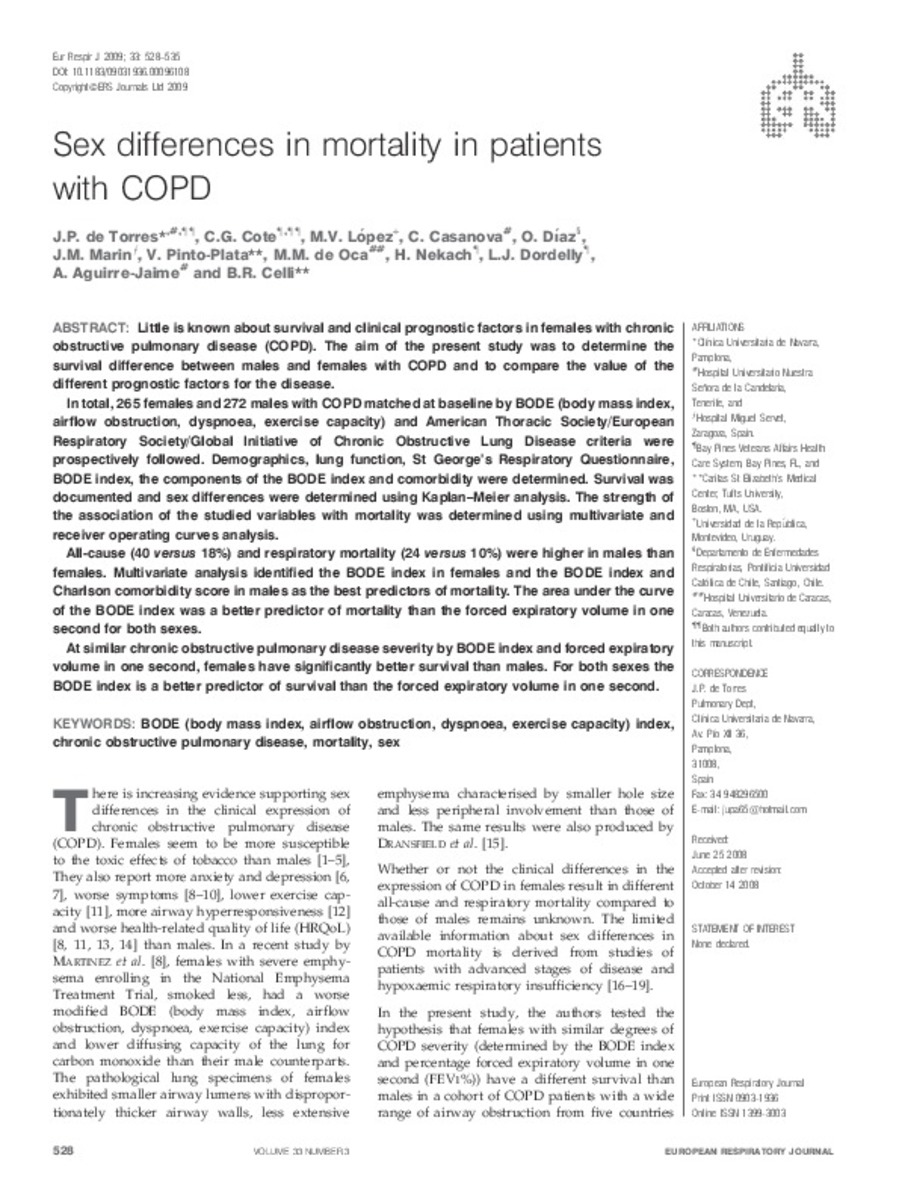Full metadata record
| DC Field | Value | Language |
|---|---|---|
| dc.creator | Torres, J.P. (Juan P.) de | - |
| dc.creator | Cote, C.G. (C.G.) | - |
| dc.creator | Lopez, M.V. (M.V.) | - |
| dc.creator | Casanova, C. (Ciro) | - |
| dc.creator | Diaz, O. (O.) | - |
| dc.creator | Marin, J.M. (José M.) | - |
| dc.creator | Pinto-Plata, V. (Víctor) | - |
| dc.creator | Oca, M.M. (M.M.) de | - |
| dc.creator | Nekach, V. (V.) | - |
| dc.creator | Dordelly, L.J. (L. J.) | - |
| dc.creator | Aguirre-Jaime, A. (Armando) | - |
| dc.creator | Celli, B.R. (Bartolomé R.) | - |
| dc.date.accessioned | 2012-07-17T12:40:07Z | - |
| dc.date.available | 2012-07-17T12:40:07Z | - |
| dc.date.issued | 2009 | - |
| dc.identifier.citation | de Torres JP, Cote CG, Lopez MV, Casanova C, Diaz O, Marin JM, et al. Sex differences in mortality in patients with COPD. Eur Respir J 2009 Mar;33(3):528-535. | es_ES |
| dc.identifier.issn | 0903-1936 | - |
| dc.identifier.uri | https://hdl.handle.net/10171/22909 | - |
| dc.description.abstract | Little is known about survival and clinical prognostic factors in females with chronic obstructive pulmonary disease (COPD). The aim of the present study was to determine the survival difference between males and females with COPD and to compare the value of the different prognostic factors for the disease. In total, 265 females and 272 males with COPD matched at baseline by BODE (body mass index, airflow obstruction, dyspnoea, exercise capacity) and American Thoracic Society/European Respiratory Society/Global Initiative of Chronic Obstructive Lung Disease criteria were prospectively followed. Demographics, lung function, St George’s Respiratory Questionnaire, BODE index, the components of the BODE index and comorbidity were determined. Survival was documented and sex differences were determined using Kaplan–Meier analysis. The strength of the association of the studied variables with mortality was determined using multivariate and receiver operating curves analysis. All-cause (40 versus 18%) and respiratory mortality (24 versus 10%) were higher in males than females. Multivariate analysis identified the BODE index in females and the BODE index and Charlson comorbidity score in males as the best predictors of mortality. The area under the curve of the BODE index was a better predictor of mortality than the forced expiratory volume in one second for both sexes. At similar chronic obstructive pulmonary disease severity by BODE index and forced expiratory volume in one second, females have significantly better survival than males. For both sexes the BODE index is a better predictor of survival than the forced expiratory volume in one second. | es_ES |
| dc.language.iso | eng | es_ES |
| dc.publisher | European Respiratory Society | es_ES |
| dc.rights | info:eu-repo/semantics/openAccess | es_ES |
| dc.subject | BODE | es_ES |
| dc.subject | Chronic obstructive pulmonary disease | es_ES |
| dc.subject | Mortality | es_ES |
| dc.title | Sex differences in mortality in patients with COPD | es_ES |
| dc.type | info:eu-repo/semantics/article | es_ES |
| dc.relation.publisherversion | http://erj.ersjournals.com/content/33/3/528.full.pdf+html | es_ES |
| dc.type.driver | info:eu-repo/semantics/article | es_ES |
Files in This Item:
Statistics and impact
Items in Dadun are protected by copyright, with all rights reserved, unless otherwise indicated.






